Research Paper: Traditional and Design & Construct Procurement Methods
VerifiedAdded on 2021/04/16
|22
|5505
|47
Report
AI Summary
This research paper provides a comparative analysis of traditional and design and construct procurement methods within the Australian construction industry. It begins with an introduction to the industry's contribution to the GDP and highlights the prevalence of various procurement approaches, including Alliancing, PPP, Design and Construct, and Traditional methods. The paper identifies the increasing popularity of the design and construct method and the challenges associated with the traditional approach. The research question focuses on determining the better procurement method for large infrastructure projects. The literature review delves into the definitions, advantages, and disadvantages of both methods, examining their influence on the Australian construction industry. The traditional method is examined for its benefits such as high construction quality and competitive tendering, but also drawbacks such as communication challenges. The design and construct method is discussed for its integrated approach, enabling contractor input in planning and design, as well as benefits of multi-disciplinary teams and improved communication. The report aims to evaluate the performance, benefits, and drawbacks of both methods to determine the most appropriate procurement strategy for enhancing infrastructure project performance and minimizing potential risks.
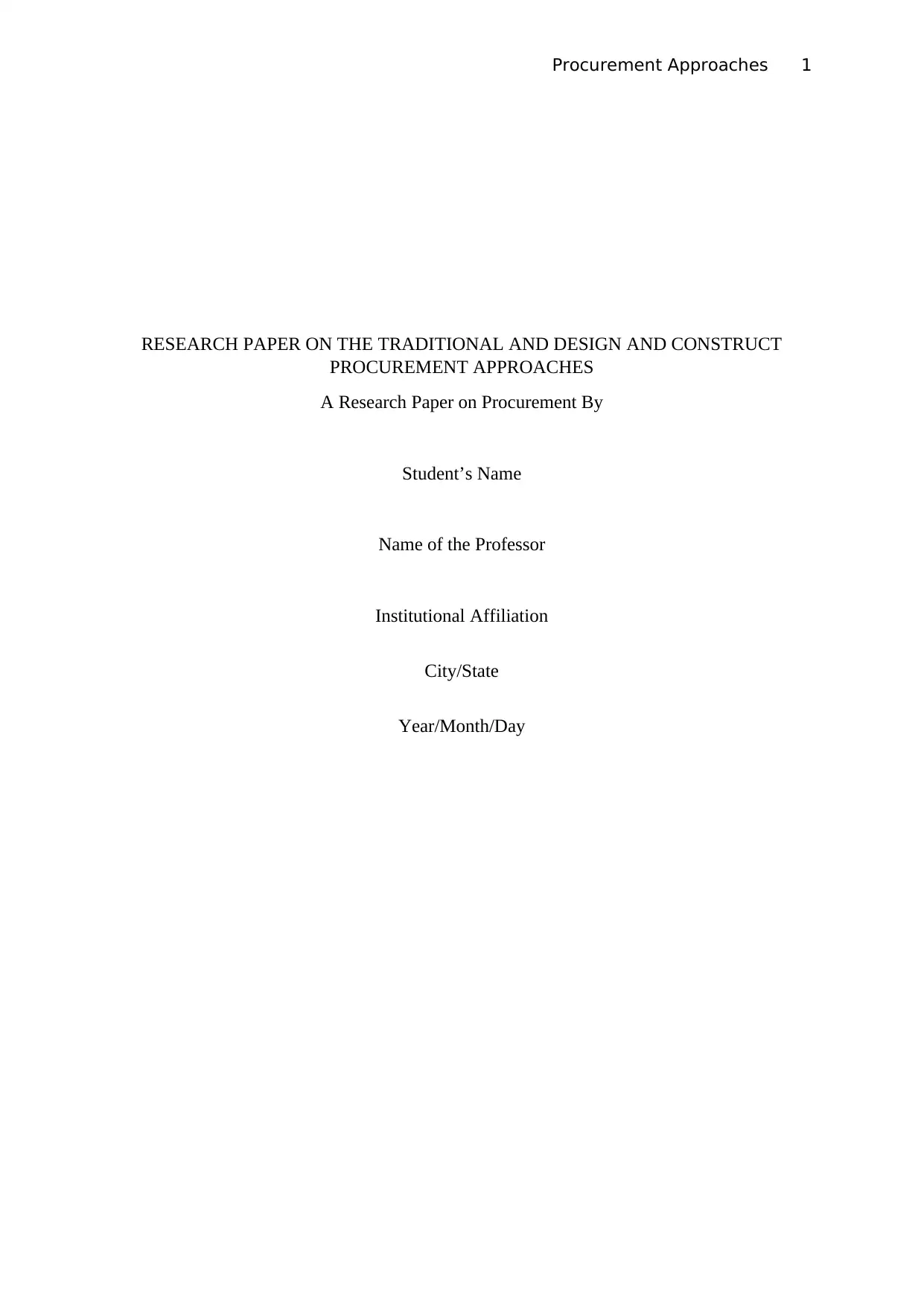
Procurement Approaches 1
RESEARCH PAPER ON THE TRADITIONAL AND DESIGN AND CONSTRUCT
PROCUREMENT APPROACHES
A Research Paper on Procurement By
Student’s Name
Name of the Professor
Institutional Affiliation
City/State
Year/Month/Day
RESEARCH PAPER ON THE TRADITIONAL AND DESIGN AND CONSTRUCT
PROCUREMENT APPROACHES
A Research Paper on Procurement By
Student’s Name
Name of the Professor
Institutional Affiliation
City/State
Year/Month/Day
Paraphrase This Document
Need a fresh take? Get an instant paraphrase of this document with our AI Paraphraser
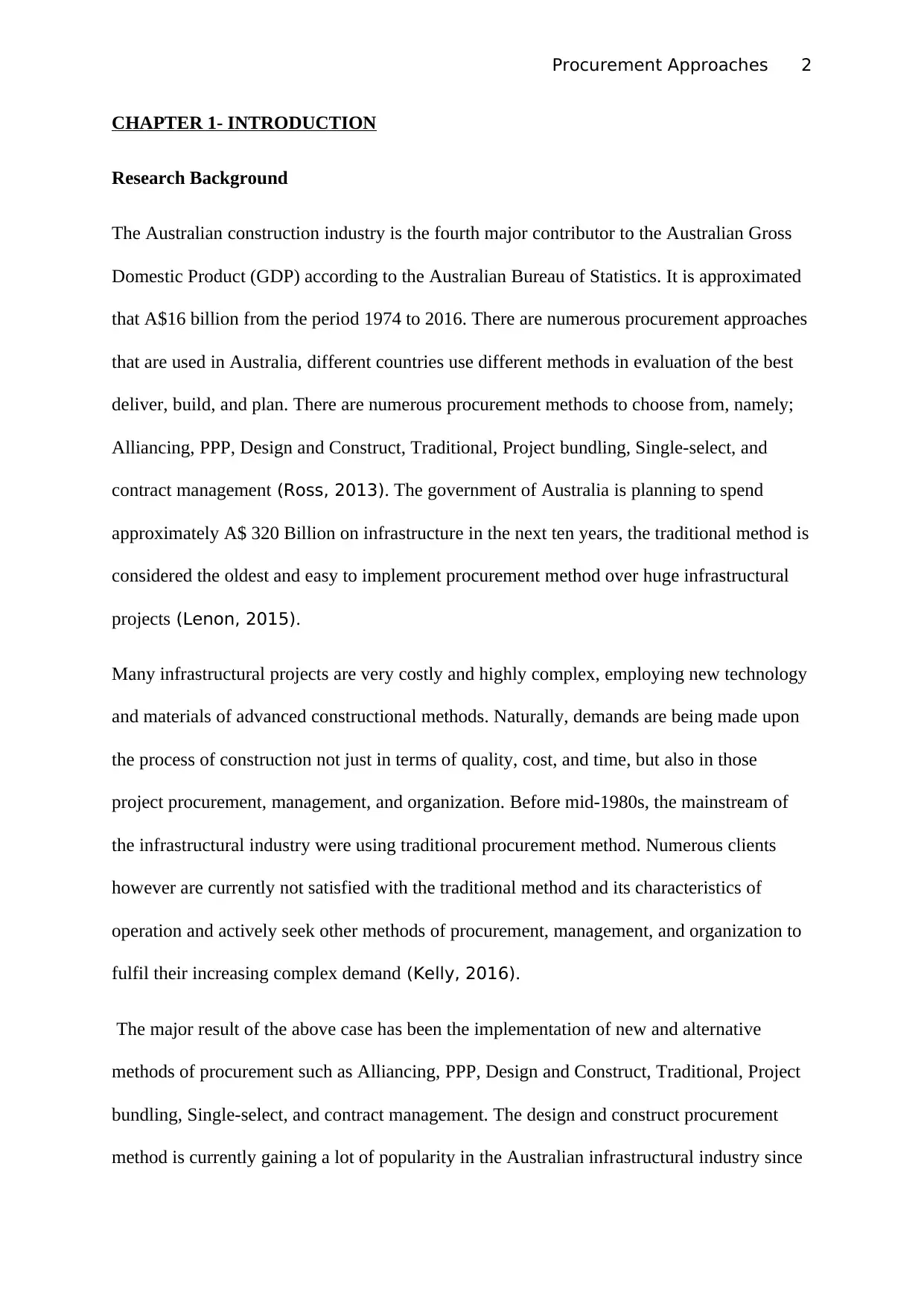
Procurement Approaches 2
CHAPTER 1- INTRODUCTION
Research Background
The Australian construction industry is the fourth major contributor to the Australian Gross
Domestic Product (GDP) according to the Australian Bureau of Statistics. It is approximated
that A$16 billion from the period 1974 to 2016. There are numerous procurement approaches
that are used in Australia, different countries use different methods in evaluation of the best
deliver, build, and plan. There are numerous procurement methods to choose from, namely;
Alliancing, PPP, Design and Construct, Traditional, Project bundling, Single-select, and
contract management (Ross, 2013). The government of Australia is planning to spend
approximately A$ 320 Billion on infrastructure in the next ten years, the traditional method is
considered the oldest and easy to implement procurement method over huge infrastructural
projects (Lenon, 2015).
Many infrastructural projects are very costly and highly complex, employing new technology
and materials of advanced constructional methods. Naturally, demands are being made upon
the process of construction not just in terms of quality, cost, and time, but also in those
project procurement, management, and organization. Before mid-1980s, the mainstream of
the infrastructural industry were using traditional procurement method. Numerous clients
however are currently not satisfied with the traditional method and its characteristics of
operation and actively seek other methods of procurement, management, and organization to
fulfil their increasing complex demand (Kelly, 2016).
The major result of the above case has been the implementation of new and alternative
methods of procurement such as Alliancing, PPP, Design and Construct, Traditional, Project
bundling, Single-select, and contract management. The design and construct procurement
method is currently gaining a lot of popularity in the Australian infrastructural industry since
CHAPTER 1- INTRODUCTION
Research Background
The Australian construction industry is the fourth major contributor to the Australian Gross
Domestic Product (GDP) according to the Australian Bureau of Statistics. It is approximated
that A$16 billion from the period 1974 to 2016. There are numerous procurement approaches
that are used in Australia, different countries use different methods in evaluation of the best
deliver, build, and plan. There are numerous procurement methods to choose from, namely;
Alliancing, PPP, Design and Construct, Traditional, Project bundling, Single-select, and
contract management (Ross, 2013). The government of Australia is planning to spend
approximately A$ 320 Billion on infrastructure in the next ten years, the traditional method is
considered the oldest and easy to implement procurement method over huge infrastructural
projects (Lenon, 2015).
Many infrastructural projects are very costly and highly complex, employing new technology
and materials of advanced constructional methods. Naturally, demands are being made upon
the process of construction not just in terms of quality, cost, and time, but also in those
project procurement, management, and organization. Before mid-1980s, the mainstream of
the infrastructural industry were using traditional procurement method. Numerous clients
however are currently not satisfied with the traditional method and its characteristics of
operation and actively seek other methods of procurement, management, and organization to
fulfil their increasing complex demand (Kelly, 2016).
The major result of the above case has been the implementation of new and alternative
methods of procurement such as Alliancing, PPP, Design and Construct, Traditional, Project
bundling, Single-select, and contract management. The design and construct procurement
method is currently gaining a lot of popularity in the Australian infrastructural industry since
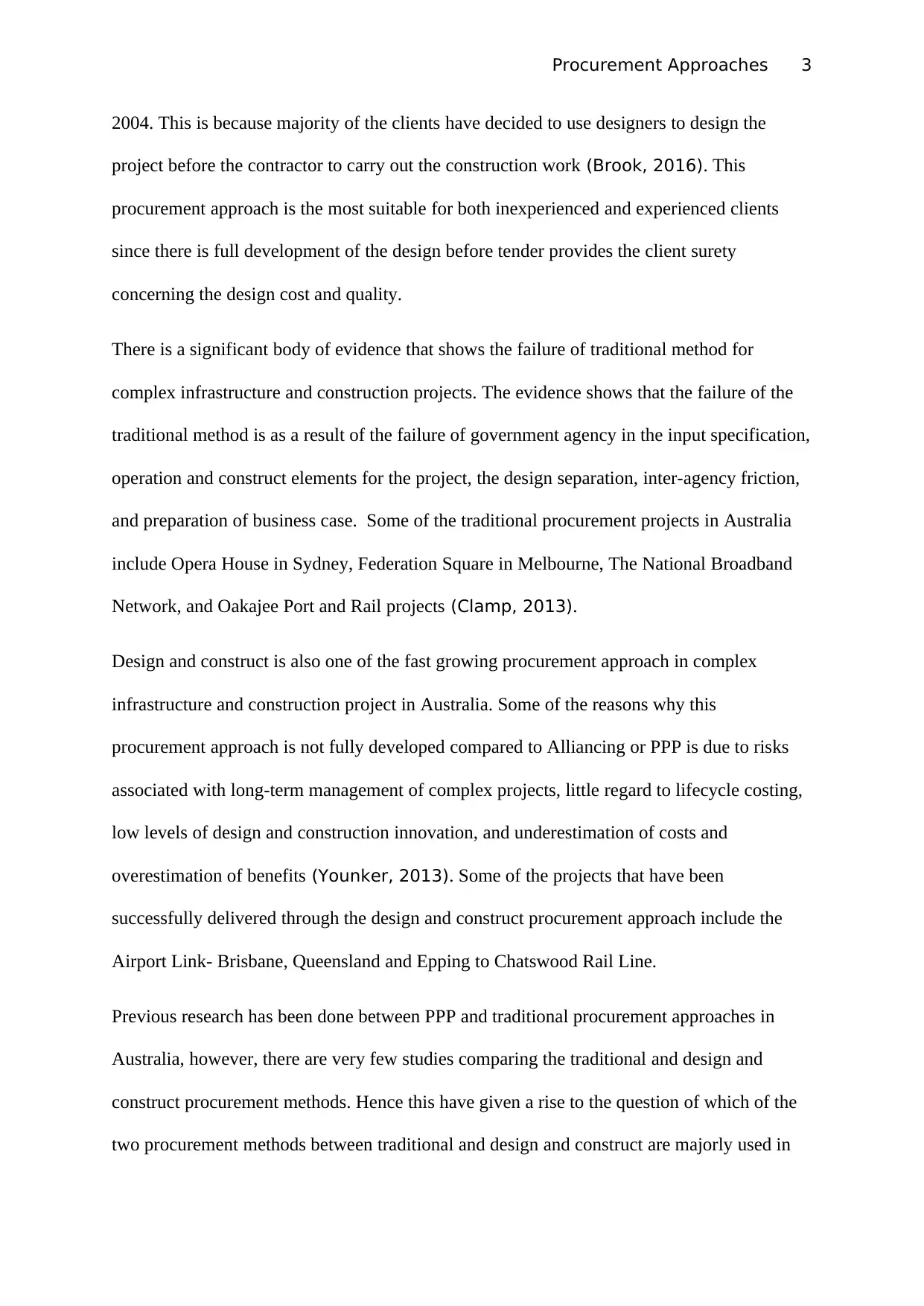
Procurement Approaches 3
2004. This is because majority of the clients have decided to use designers to design the
project before the contractor to carry out the construction work (Brook, 2016). This
procurement approach is the most suitable for both inexperienced and experienced clients
since there is full development of the design before tender provides the client surety
concerning the design cost and quality.
There is a significant body of evidence that shows the failure of traditional method for
complex infrastructure and construction projects. The evidence shows that the failure of the
traditional method is as a result of the failure of government agency in the input specification,
operation and construct elements for the project, the design separation, inter-agency friction,
and preparation of business case. Some of the traditional procurement projects in Australia
include Opera House in Sydney, Federation Square in Melbourne, The National Broadband
Network, and Oakajee Port and Rail projects (Clamp, 2013).
Design and construct is also one of the fast growing procurement approach in complex
infrastructure and construction project in Australia. Some of the reasons why this
procurement approach is not fully developed compared to Alliancing or PPP is due to risks
associated with long-term management of complex projects, little regard to lifecycle costing,
low levels of design and construction innovation, and underestimation of costs and
overestimation of benefits (Younker, 2013). Some of the projects that have been
successfully delivered through the design and construct procurement approach include the
Airport Link- Brisbane, Queensland and Epping to Chatswood Rail Line.
Previous research has been done between PPP and traditional procurement approaches in
Australia, however, there are very few studies comparing the traditional and design and
construct procurement methods. Hence this have given a rise to the question of which of the
two procurement methods between traditional and design and construct are majorly used in
2004. This is because majority of the clients have decided to use designers to design the
project before the contractor to carry out the construction work (Brook, 2016). This
procurement approach is the most suitable for both inexperienced and experienced clients
since there is full development of the design before tender provides the client surety
concerning the design cost and quality.
There is a significant body of evidence that shows the failure of traditional method for
complex infrastructure and construction projects. The evidence shows that the failure of the
traditional method is as a result of the failure of government agency in the input specification,
operation and construct elements for the project, the design separation, inter-agency friction,
and preparation of business case. Some of the traditional procurement projects in Australia
include Opera House in Sydney, Federation Square in Melbourne, The National Broadband
Network, and Oakajee Port and Rail projects (Clamp, 2013).
Design and construct is also one of the fast growing procurement approach in complex
infrastructure and construction project in Australia. Some of the reasons why this
procurement approach is not fully developed compared to Alliancing or PPP is due to risks
associated with long-term management of complex projects, little regard to lifecycle costing,
low levels of design and construction innovation, and underestimation of costs and
overestimation of benefits (Younker, 2013). Some of the projects that have been
successfully delivered through the design and construct procurement approach include the
Airport Link- Brisbane, Queensland and Epping to Chatswood Rail Line.
Previous research has been done between PPP and traditional procurement approaches in
Australia, however, there are very few studies comparing the traditional and design and
construct procurement methods. Hence this have given a rise to the question of which of the
two procurement methods between traditional and design and construct are majorly used in
⊘ This is a preview!⊘
Do you want full access?
Subscribe today to unlock all pages.

Trusted by 1+ million students worldwide
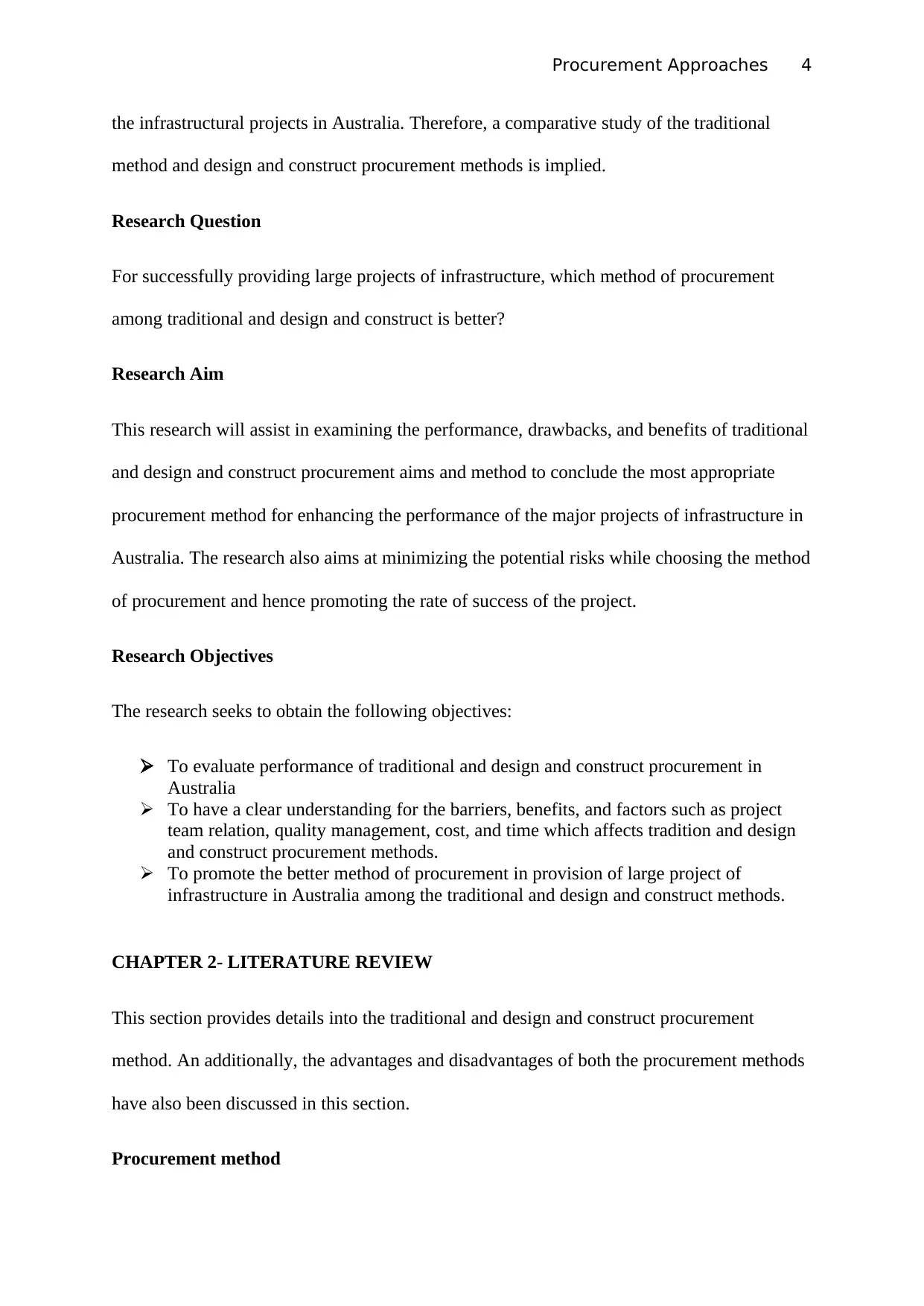
Procurement Approaches 4
the infrastructural projects in Australia. Therefore, a comparative study of the traditional
method and design and construct procurement methods is implied.
Research Question
For successfully providing large projects of infrastructure, which method of procurement
among traditional and design and construct is better?
Research Aim
This research will assist in examining the performance, drawbacks, and benefits of traditional
and design and construct procurement aims and method to conclude the most appropriate
procurement method for enhancing the performance of the major projects of infrastructure in
Australia. The research also aims at minimizing the potential risks while choosing the method
of procurement and hence promoting the rate of success of the project.
Research Objectives
The research seeks to obtain the following objectives:
To evaluate performance of traditional and design and construct procurement in
Australia
To have a clear understanding for the barriers, benefits, and factors such as project
team relation, quality management, cost, and time which affects tradition and design
and construct procurement methods.
To promote the better method of procurement in provision of large project of
infrastructure in Australia among the traditional and design and construct methods.
CHAPTER 2- LITERATURE REVIEW
This section provides details into the traditional and design and construct procurement
method. An additionally, the advantages and disadvantages of both the procurement methods
have also been discussed in this section.
Procurement method
the infrastructural projects in Australia. Therefore, a comparative study of the traditional
method and design and construct procurement methods is implied.
Research Question
For successfully providing large projects of infrastructure, which method of procurement
among traditional and design and construct is better?
Research Aim
This research will assist in examining the performance, drawbacks, and benefits of traditional
and design and construct procurement aims and method to conclude the most appropriate
procurement method for enhancing the performance of the major projects of infrastructure in
Australia. The research also aims at minimizing the potential risks while choosing the method
of procurement and hence promoting the rate of success of the project.
Research Objectives
The research seeks to obtain the following objectives:
To evaluate performance of traditional and design and construct procurement in
Australia
To have a clear understanding for the barriers, benefits, and factors such as project
team relation, quality management, cost, and time which affects tradition and design
and construct procurement methods.
To promote the better method of procurement in provision of large project of
infrastructure in Australia among the traditional and design and construct methods.
CHAPTER 2- LITERATURE REVIEW
This section provides details into the traditional and design and construct procurement
method. An additionally, the advantages and disadvantages of both the procurement methods
have also been discussed in this section.
Procurement method
Paraphrase This Document
Need a fresh take? Get an instant paraphrase of this document with our AI Paraphraser
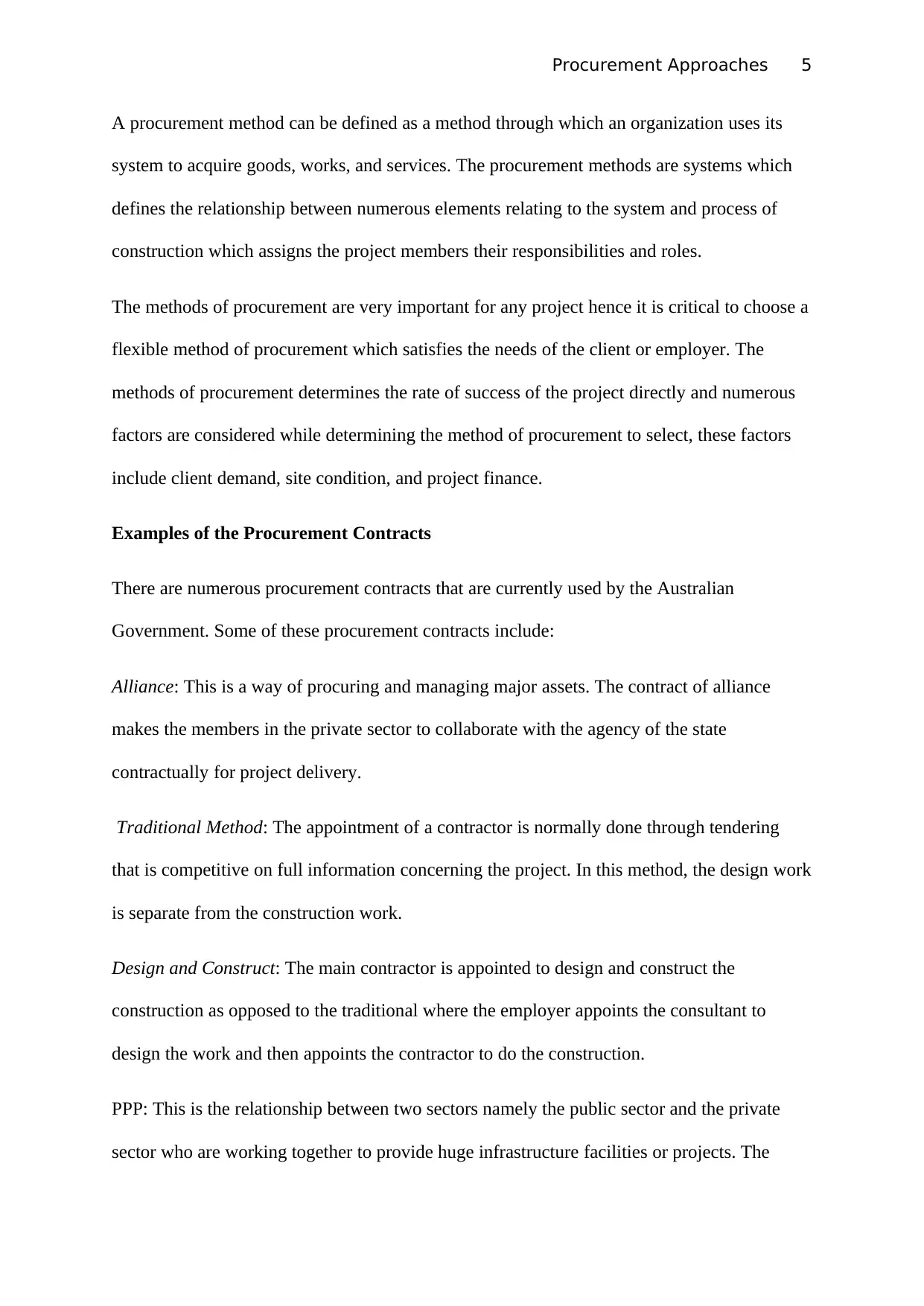
Procurement Approaches 5
A procurement method can be defined as a method through which an organization uses its
system to acquire goods, works, and services. The procurement methods are systems which
defines the relationship between numerous elements relating to the system and process of
construction which assigns the project members their responsibilities and roles.
The methods of procurement are very important for any project hence it is critical to choose a
flexible method of procurement which satisfies the needs of the client or employer. The
methods of procurement determines the rate of success of the project directly and numerous
factors are considered while determining the method of procurement to select, these factors
include client demand, site condition, and project finance.
Examples of the Procurement Contracts
There are numerous procurement contracts that are currently used by the Australian
Government. Some of these procurement contracts include:
Alliance: This is a way of procuring and managing major assets. The contract of alliance
makes the members in the private sector to collaborate with the agency of the state
contractually for project delivery.
Traditional Method: The appointment of a contractor is normally done through tendering
that is competitive on full information concerning the project. In this method, the design work
is separate from the construction work.
Design and Construct: The main contractor is appointed to design and construct the
construction as opposed to the traditional where the employer appoints the consultant to
design the work and then appoints the contractor to do the construction.
PPP: This is the relationship between two sectors namely the public sector and the private
sector who are working together to provide huge infrastructure facilities or projects. The
A procurement method can be defined as a method through which an organization uses its
system to acquire goods, works, and services. The procurement methods are systems which
defines the relationship between numerous elements relating to the system and process of
construction which assigns the project members their responsibilities and roles.
The methods of procurement are very important for any project hence it is critical to choose a
flexible method of procurement which satisfies the needs of the client or employer. The
methods of procurement determines the rate of success of the project directly and numerous
factors are considered while determining the method of procurement to select, these factors
include client demand, site condition, and project finance.
Examples of the Procurement Contracts
There are numerous procurement contracts that are currently used by the Australian
Government. Some of these procurement contracts include:
Alliance: This is a way of procuring and managing major assets. The contract of alliance
makes the members in the private sector to collaborate with the agency of the state
contractually for project delivery.
Traditional Method: The appointment of a contractor is normally done through tendering
that is competitive on full information concerning the project. In this method, the design work
is separate from the construction work.
Design and Construct: The main contractor is appointed to design and construct the
construction as opposed to the traditional where the employer appoints the consultant to
design the work and then appoints the contractor to do the construction.
PPP: This is the relationship between two sectors namely the public sector and the private
sector who are working together to provide huge infrastructure facilities or projects. The
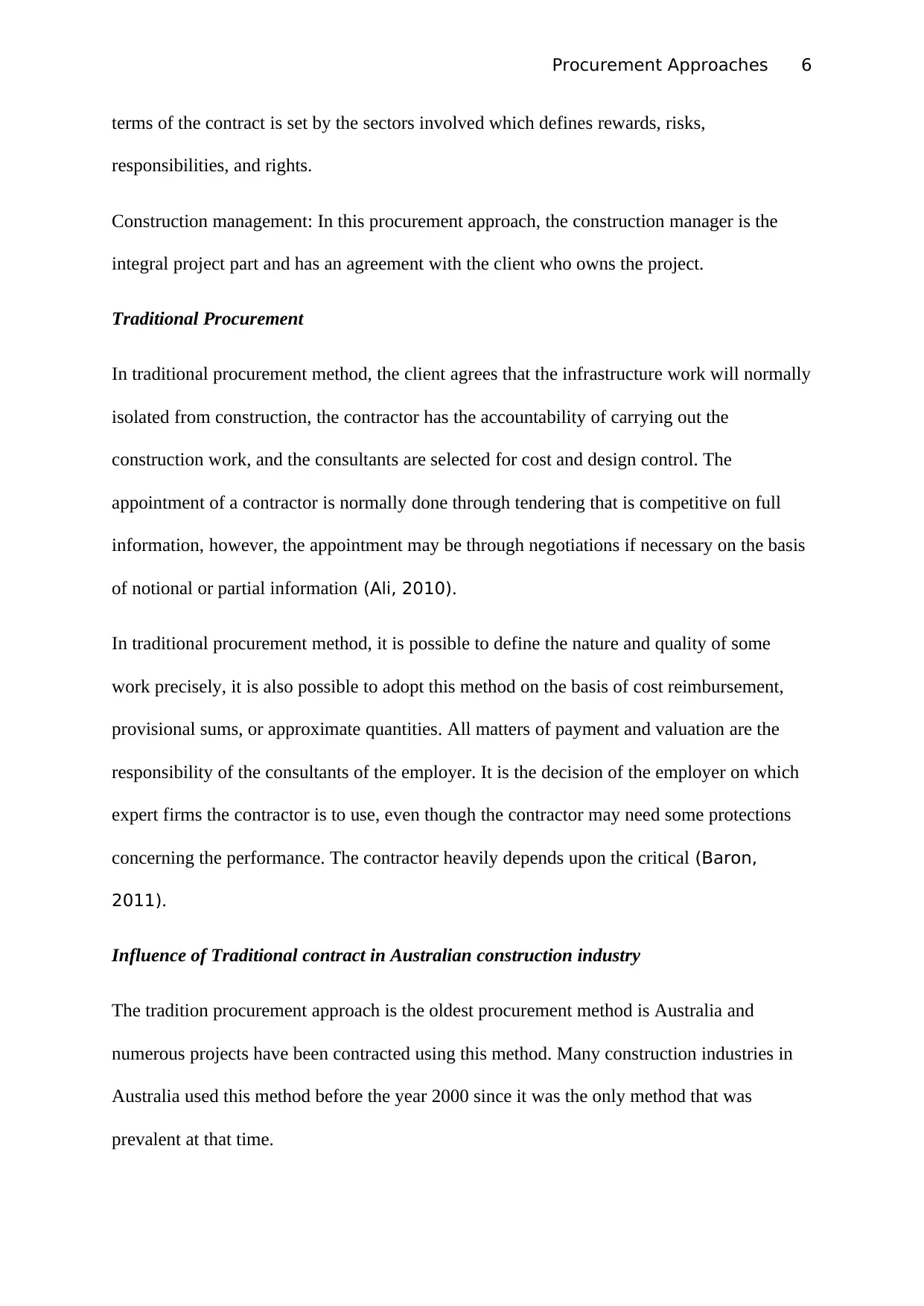
Procurement Approaches 6
terms of the contract is set by the sectors involved which defines rewards, risks,
responsibilities, and rights.
Construction management: In this procurement approach, the construction manager is the
integral project part and has an agreement with the client who owns the project.
Traditional Procurement
In traditional procurement method, the client agrees that the infrastructure work will normally
isolated from construction, the contractor has the accountability of carrying out the
construction work, and the consultants are selected for cost and design control. The
appointment of a contractor is normally done through tendering that is competitive on full
information, however, the appointment may be through negotiations if necessary on the basis
of notional or partial information (Ali, 2010).
In traditional procurement method, it is possible to define the nature and quality of some
work precisely, it is also possible to adopt this method on the basis of cost reimbursement,
provisional sums, or approximate quantities. All matters of payment and valuation are the
responsibility of the consultants of the employer. It is the decision of the employer on which
expert firms the contractor is to use, even though the contractor may need some protections
concerning the performance. The contractor heavily depends upon the critical (Baron,
2011).
Influence of Traditional contract in Australian construction industry
The tradition procurement approach is the oldest procurement method is Australia and
numerous projects have been contracted using this method. Many construction industries in
Australia used this method before the year 2000 since it was the only method that was
prevalent at that time.
terms of the contract is set by the sectors involved which defines rewards, risks,
responsibilities, and rights.
Construction management: In this procurement approach, the construction manager is the
integral project part and has an agreement with the client who owns the project.
Traditional Procurement
In traditional procurement method, the client agrees that the infrastructure work will normally
isolated from construction, the contractor has the accountability of carrying out the
construction work, and the consultants are selected for cost and design control. The
appointment of a contractor is normally done through tendering that is competitive on full
information, however, the appointment may be through negotiations if necessary on the basis
of notional or partial information (Ali, 2010).
In traditional procurement method, it is possible to define the nature and quality of some
work precisely, it is also possible to adopt this method on the basis of cost reimbursement,
provisional sums, or approximate quantities. All matters of payment and valuation are the
responsibility of the consultants of the employer. It is the decision of the employer on which
expert firms the contractor is to use, even though the contractor may need some protections
concerning the performance. The contractor heavily depends upon the critical (Baron,
2011).
Influence of Traditional contract in Australian construction industry
The tradition procurement approach is the oldest procurement method is Australia and
numerous projects have been contracted using this method. Many construction industries in
Australia used this method before the year 2000 since it was the only method that was
prevalent at that time.
⊘ This is a preview!⊘
Do you want full access?
Subscribe today to unlock all pages.

Trusted by 1+ million students worldwide
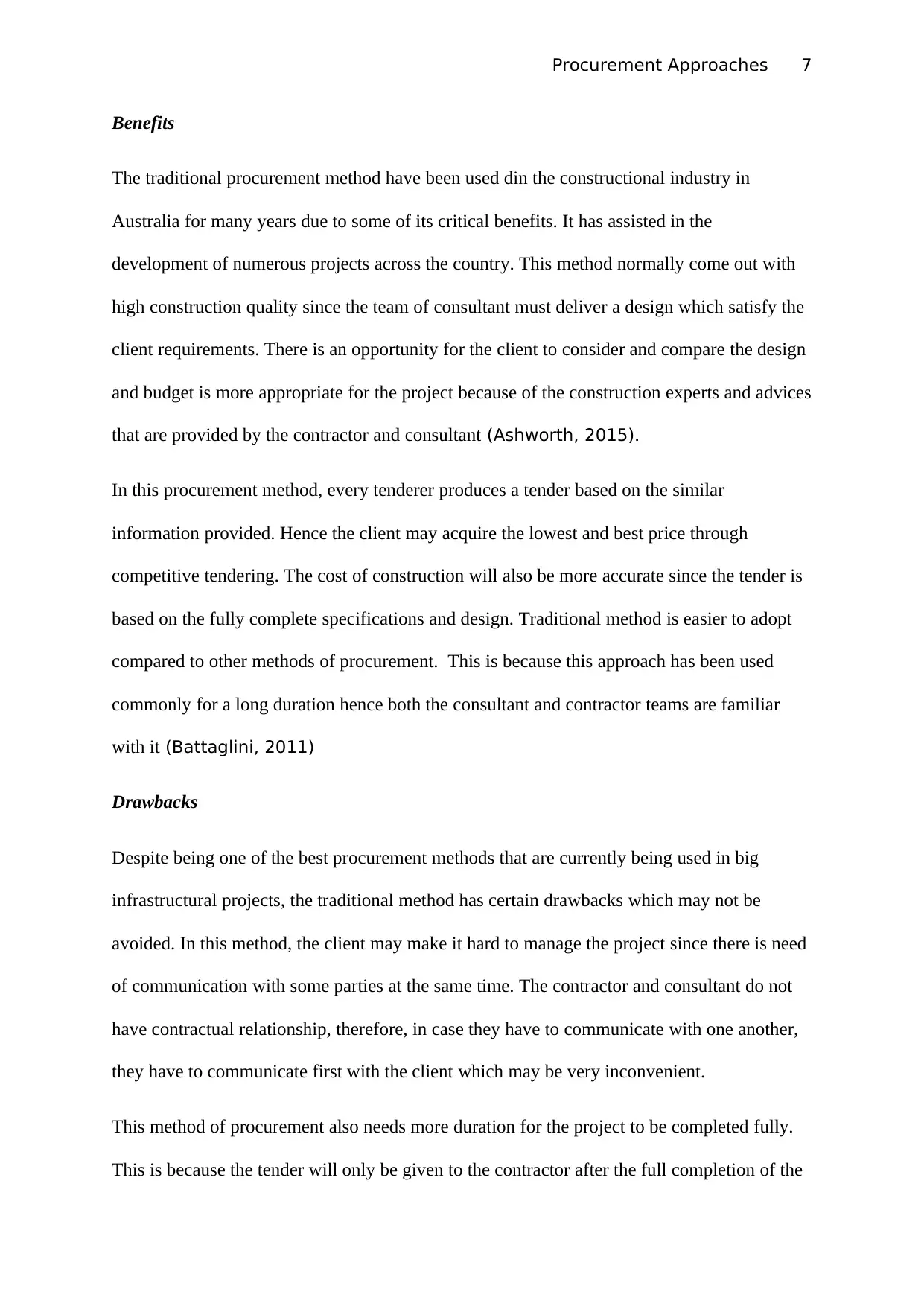
Procurement Approaches 7
Benefits
The traditional procurement method have been used din the constructional industry in
Australia for many years due to some of its critical benefits. It has assisted in the
development of numerous projects across the country. This method normally come out with
high construction quality since the team of consultant must deliver a design which satisfy the
client requirements. There is an opportunity for the client to consider and compare the design
and budget is more appropriate for the project because of the construction experts and advices
that are provided by the contractor and consultant (Ashworth, 2015).
In this procurement method, every tenderer produces a tender based on the similar
information provided. Hence the client may acquire the lowest and best price through
competitive tendering. The cost of construction will also be more accurate since the tender is
based on the fully complete specifications and design. Traditional method is easier to adopt
compared to other methods of procurement. This is because this approach has been used
commonly for a long duration hence both the consultant and contractor teams are familiar
with it (Battaglini, 2011)
Drawbacks
Despite being one of the best procurement methods that are currently being used in big
infrastructural projects, the traditional method has certain drawbacks which may not be
avoided. In this method, the client may make it hard to manage the project since there is need
of communication with some parties at the same time. The contractor and consultant do not
have contractual relationship, therefore, in case they have to communicate with one another,
they have to communicate first with the client which may be very inconvenient.
This method of procurement also needs more duration for the project to be completed fully.
This is because the tender will only be given to the contractor after the full completion of the
Benefits
The traditional procurement method have been used din the constructional industry in
Australia for many years due to some of its critical benefits. It has assisted in the
development of numerous projects across the country. This method normally come out with
high construction quality since the team of consultant must deliver a design which satisfy the
client requirements. There is an opportunity for the client to consider and compare the design
and budget is more appropriate for the project because of the construction experts and advices
that are provided by the contractor and consultant (Ashworth, 2015).
In this procurement method, every tenderer produces a tender based on the similar
information provided. Hence the client may acquire the lowest and best price through
competitive tendering. The cost of construction will also be more accurate since the tender is
based on the fully complete specifications and design. Traditional method is easier to adopt
compared to other methods of procurement. This is because this approach has been used
commonly for a long duration hence both the consultant and contractor teams are familiar
with it (Battaglini, 2011)
Drawbacks
Despite being one of the best procurement methods that are currently being used in big
infrastructural projects, the traditional method has certain drawbacks which may not be
avoided. In this method, the client may make it hard to manage the project since there is need
of communication with some parties at the same time. The contractor and consultant do not
have contractual relationship, therefore, in case they have to communicate with one another,
they have to communicate first with the client which may be very inconvenient.
This method of procurement also needs more duration for the project to be completed fully.
This is because the tender will only be given to the contractor after the full completion of the
Paraphrase This Document
Need a fresh take? Get an instant paraphrase of this document with our AI Paraphraser
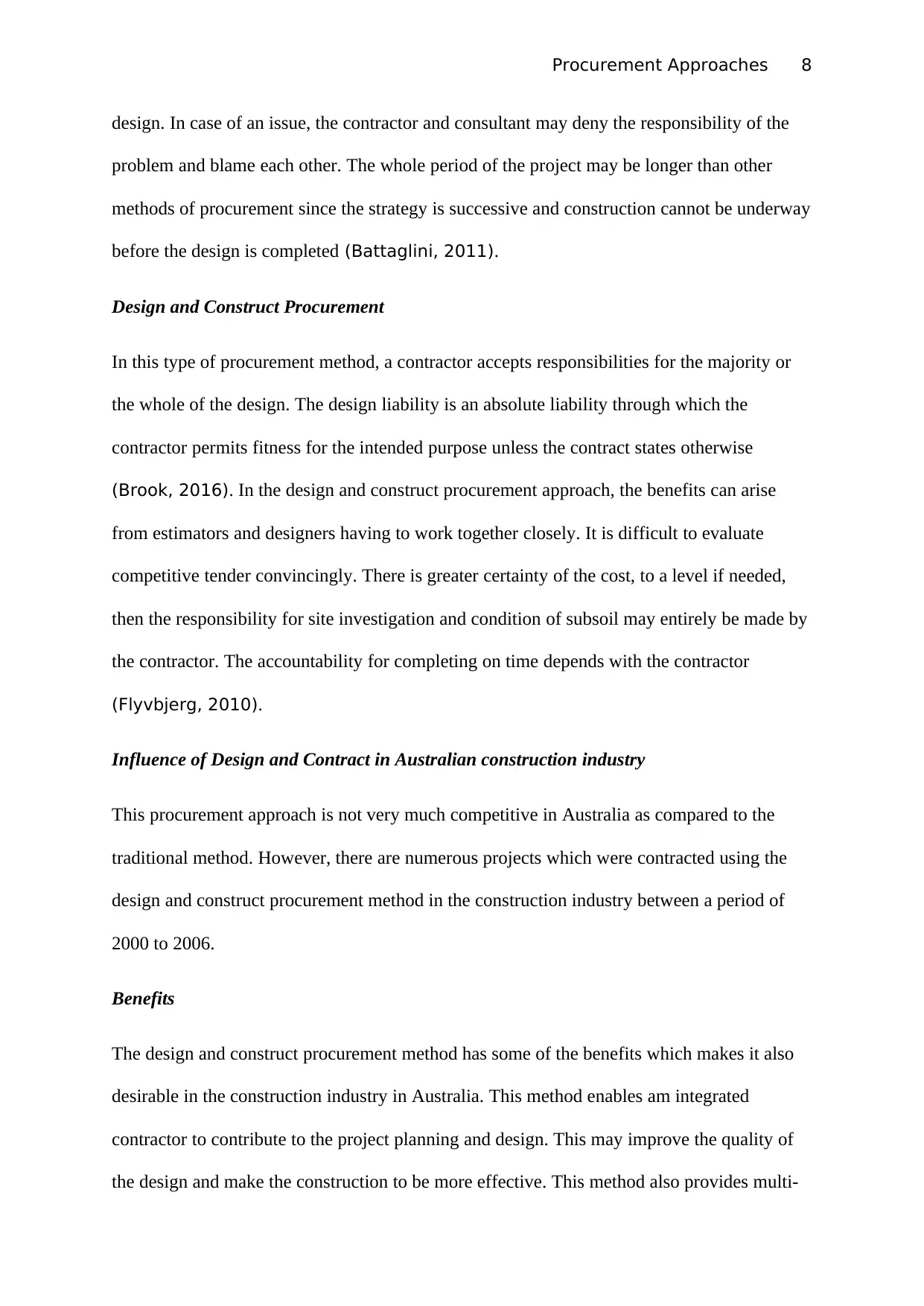
Procurement Approaches 8
design. In case of an issue, the contractor and consultant may deny the responsibility of the
problem and blame each other. The whole period of the project may be longer than other
methods of procurement since the strategy is successive and construction cannot be underway
before the design is completed (Battaglini, 2011).
Design and Construct Procurement
In this type of procurement method, a contractor accepts responsibilities for the majority or
the whole of the design. The design liability is an absolute liability through which the
contractor permits fitness for the intended purpose unless the contract states otherwise
(Brook, 2016). In the design and construct procurement approach, the benefits can arise
from estimators and designers having to work together closely. It is difficult to evaluate
competitive tender convincingly. There is greater certainty of the cost, to a level if needed,
then the responsibility for site investigation and condition of subsoil may entirely be made by
the contractor. The accountability for completing on time depends with the contractor
(Flyvbjerg, 2010).
Influence of Design and Contract in Australian construction industry
This procurement approach is not very much competitive in Australia as compared to the
traditional method. However, there are numerous projects which were contracted using the
design and construct procurement method in the construction industry between a period of
2000 to 2006.
Benefits
The design and construct procurement method has some of the benefits which makes it also
desirable in the construction industry in Australia. This method enables am integrated
contractor to contribute to the project planning and design. This may improve the quality of
the design and make the construction to be more effective. This method also provides multi-
design. In case of an issue, the contractor and consultant may deny the responsibility of the
problem and blame each other. The whole period of the project may be longer than other
methods of procurement since the strategy is successive and construction cannot be underway
before the design is completed (Battaglini, 2011).
Design and Construct Procurement
In this type of procurement method, a contractor accepts responsibilities for the majority or
the whole of the design. The design liability is an absolute liability through which the
contractor permits fitness for the intended purpose unless the contract states otherwise
(Brook, 2016). In the design and construct procurement approach, the benefits can arise
from estimators and designers having to work together closely. It is difficult to evaluate
competitive tender convincingly. There is greater certainty of the cost, to a level if needed,
then the responsibility for site investigation and condition of subsoil may entirely be made by
the contractor. The accountability for completing on time depends with the contractor
(Flyvbjerg, 2010).
Influence of Design and Contract in Australian construction industry
This procurement approach is not very much competitive in Australia as compared to the
traditional method. However, there are numerous projects which were contracted using the
design and construct procurement method in the construction industry between a period of
2000 to 2006.
Benefits
The design and construct procurement method has some of the benefits which makes it also
desirable in the construction industry in Australia. This method enables am integrated
contractor to contribute to the project planning and design. This may improve the quality of
the design and make the construction to be more effective. This method also provides multi-
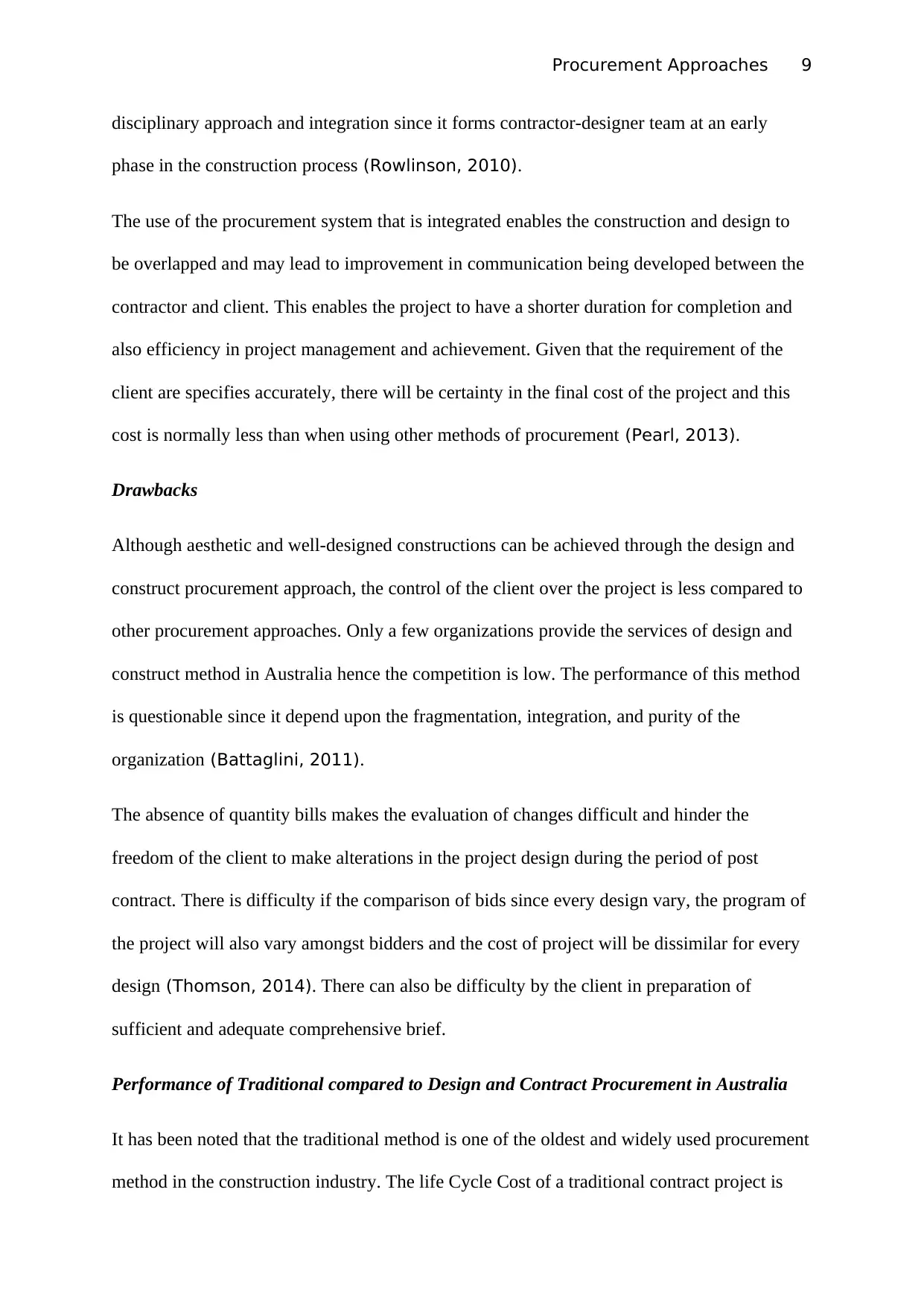
Procurement Approaches 9
disciplinary approach and integration since it forms contractor-designer team at an early
phase in the construction process (Rowlinson, 2010).
The use of the procurement system that is integrated enables the construction and design to
be overlapped and may lead to improvement in communication being developed between the
contractor and client. This enables the project to have a shorter duration for completion and
also efficiency in project management and achievement. Given that the requirement of the
client are specifies accurately, there will be certainty in the final cost of the project and this
cost is normally less than when using other methods of procurement (Pearl, 2013).
Drawbacks
Although aesthetic and well-designed constructions can be achieved through the design and
construct procurement approach, the control of the client over the project is less compared to
other procurement approaches. Only a few organizations provide the services of design and
construct method in Australia hence the competition is low. The performance of this method
is questionable since it depend upon the fragmentation, integration, and purity of the
organization (Battaglini, 2011).
The absence of quantity bills makes the evaluation of changes difficult and hinder the
freedom of the client to make alterations in the project design during the period of post
contract. There is difficulty if the comparison of bids since every design vary, the program of
the project will also vary amongst bidders and the cost of project will be dissimilar for every
design (Thomson, 2014). There can also be difficulty by the client in preparation of
sufficient and adequate comprehensive brief.
Performance of Traditional compared to Design and Contract Procurement in Australia
It has been noted that the traditional method is one of the oldest and widely used procurement
method in the construction industry. The life Cycle Cost of a traditional contract project is
disciplinary approach and integration since it forms contractor-designer team at an early
phase in the construction process (Rowlinson, 2010).
The use of the procurement system that is integrated enables the construction and design to
be overlapped and may lead to improvement in communication being developed between the
contractor and client. This enables the project to have a shorter duration for completion and
also efficiency in project management and achievement. Given that the requirement of the
client are specifies accurately, there will be certainty in the final cost of the project and this
cost is normally less than when using other methods of procurement (Pearl, 2013).
Drawbacks
Although aesthetic and well-designed constructions can be achieved through the design and
construct procurement approach, the control of the client over the project is less compared to
other procurement approaches. Only a few organizations provide the services of design and
construct method in Australia hence the competition is low. The performance of this method
is questionable since it depend upon the fragmentation, integration, and purity of the
organization (Battaglini, 2011).
The absence of quantity bills makes the evaluation of changes difficult and hinder the
freedom of the client to make alterations in the project design during the period of post
contract. There is difficulty if the comparison of bids since every design vary, the program of
the project will also vary amongst bidders and the cost of project will be dissimilar for every
design (Thomson, 2014). There can also be difficulty by the client in preparation of
sufficient and adequate comprehensive brief.
Performance of Traditional compared to Design and Contract Procurement in Australia
It has been noted that the traditional method is one of the oldest and widely used procurement
method in the construction industry. The life Cycle Cost of a traditional contract project is
⊘ This is a preview!⊘
Do you want full access?
Subscribe today to unlock all pages.

Trusted by 1+ million students worldwide
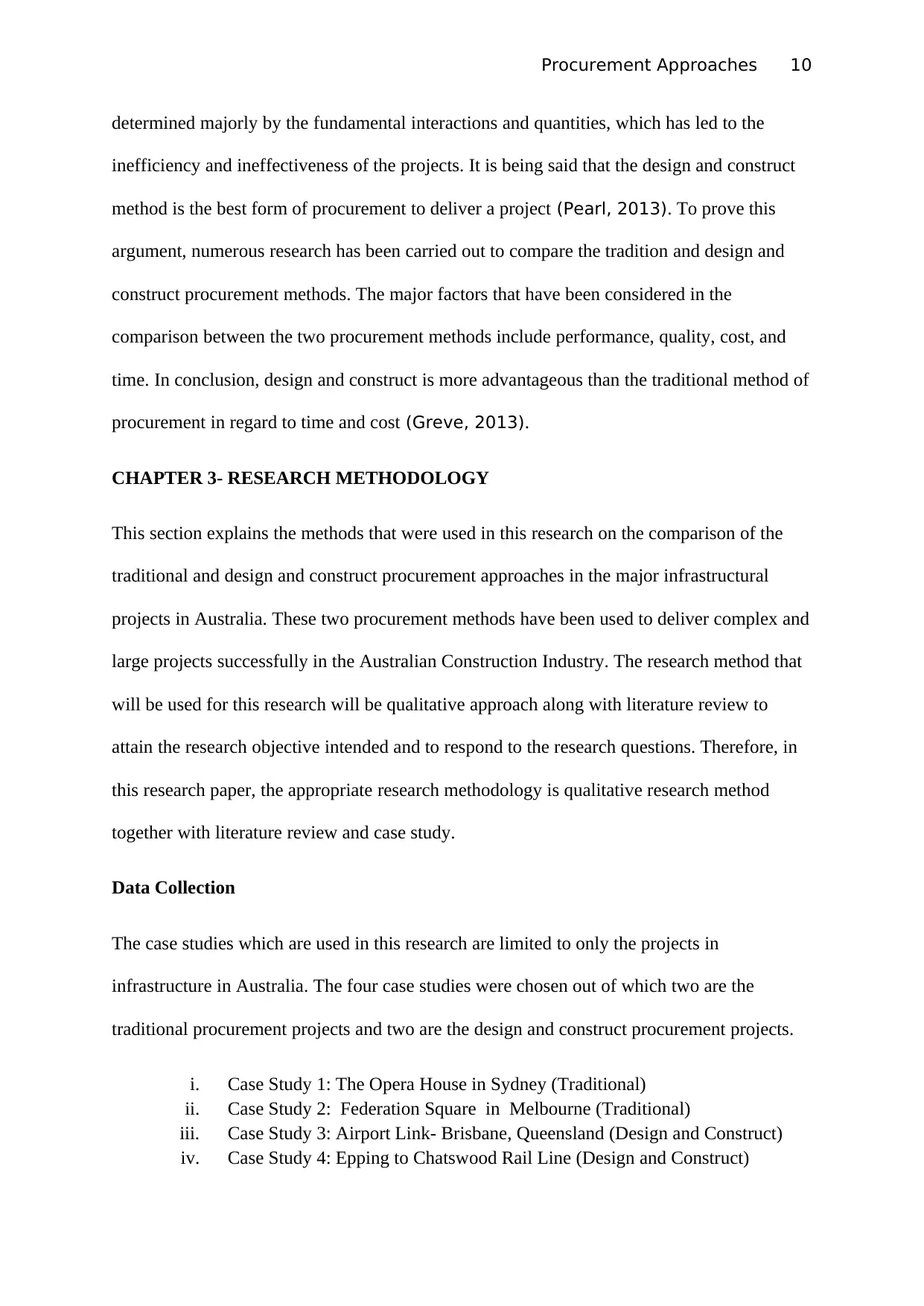
Procurement Approaches 10
determined majorly by the fundamental interactions and quantities, which has led to the
inefficiency and ineffectiveness of the projects. It is being said that the design and construct
method is the best form of procurement to deliver a project (Pearl, 2013). To prove this
argument, numerous research has been carried out to compare the tradition and design and
construct procurement methods. The major factors that have been considered in the
comparison between the two procurement methods include performance, quality, cost, and
time. In conclusion, design and construct is more advantageous than the traditional method of
procurement in regard to time and cost (Greve, 2013).
CHAPTER 3- RESEARCH METHODOLOGY
This section explains the methods that were used in this research on the comparison of the
traditional and design and construct procurement approaches in the major infrastructural
projects in Australia. These two procurement methods have been used to deliver complex and
large projects successfully in the Australian Construction Industry. The research method that
will be used for this research will be qualitative approach along with literature review to
attain the research objective intended and to respond to the research questions. Therefore, in
this research paper, the appropriate research methodology is qualitative research method
together with literature review and case study.
Data Collection
The case studies which are used in this research are limited to only the projects in
infrastructure in Australia. The four case studies were chosen out of which two are the
traditional procurement projects and two are the design and construct procurement projects.
i. Case Study 1: The Opera House in Sydney (Traditional)
ii. Case Study 2: Federation Square in Melbourne (Traditional)
iii. Case Study 3: Airport Link- Brisbane, Queensland (Design and Construct)
iv. Case Study 4: Epping to Chatswood Rail Line (Design and Construct)
determined majorly by the fundamental interactions and quantities, which has led to the
inefficiency and ineffectiveness of the projects. It is being said that the design and construct
method is the best form of procurement to deliver a project (Pearl, 2013). To prove this
argument, numerous research has been carried out to compare the tradition and design and
construct procurement methods. The major factors that have been considered in the
comparison between the two procurement methods include performance, quality, cost, and
time. In conclusion, design and construct is more advantageous than the traditional method of
procurement in regard to time and cost (Greve, 2013).
CHAPTER 3- RESEARCH METHODOLOGY
This section explains the methods that were used in this research on the comparison of the
traditional and design and construct procurement approaches in the major infrastructural
projects in Australia. These two procurement methods have been used to deliver complex and
large projects successfully in the Australian Construction Industry. The research method that
will be used for this research will be qualitative approach along with literature review to
attain the research objective intended and to respond to the research questions. Therefore, in
this research paper, the appropriate research methodology is qualitative research method
together with literature review and case study.
Data Collection
The case studies which are used in this research are limited to only the projects in
infrastructure in Australia. The four case studies were chosen out of which two are the
traditional procurement projects and two are the design and construct procurement projects.
i. Case Study 1: The Opera House in Sydney (Traditional)
ii. Case Study 2: Federation Square in Melbourne (Traditional)
iii. Case Study 3: Airport Link- Brisbane, Queensland (Design and Construct)
iv. Case Study 4: Epping to Chatswood Rail Line (Design and Construct)
Paraphrase This Document
Need a fresh take? Get an instant paraphrase of this document with our AI Paraphraser
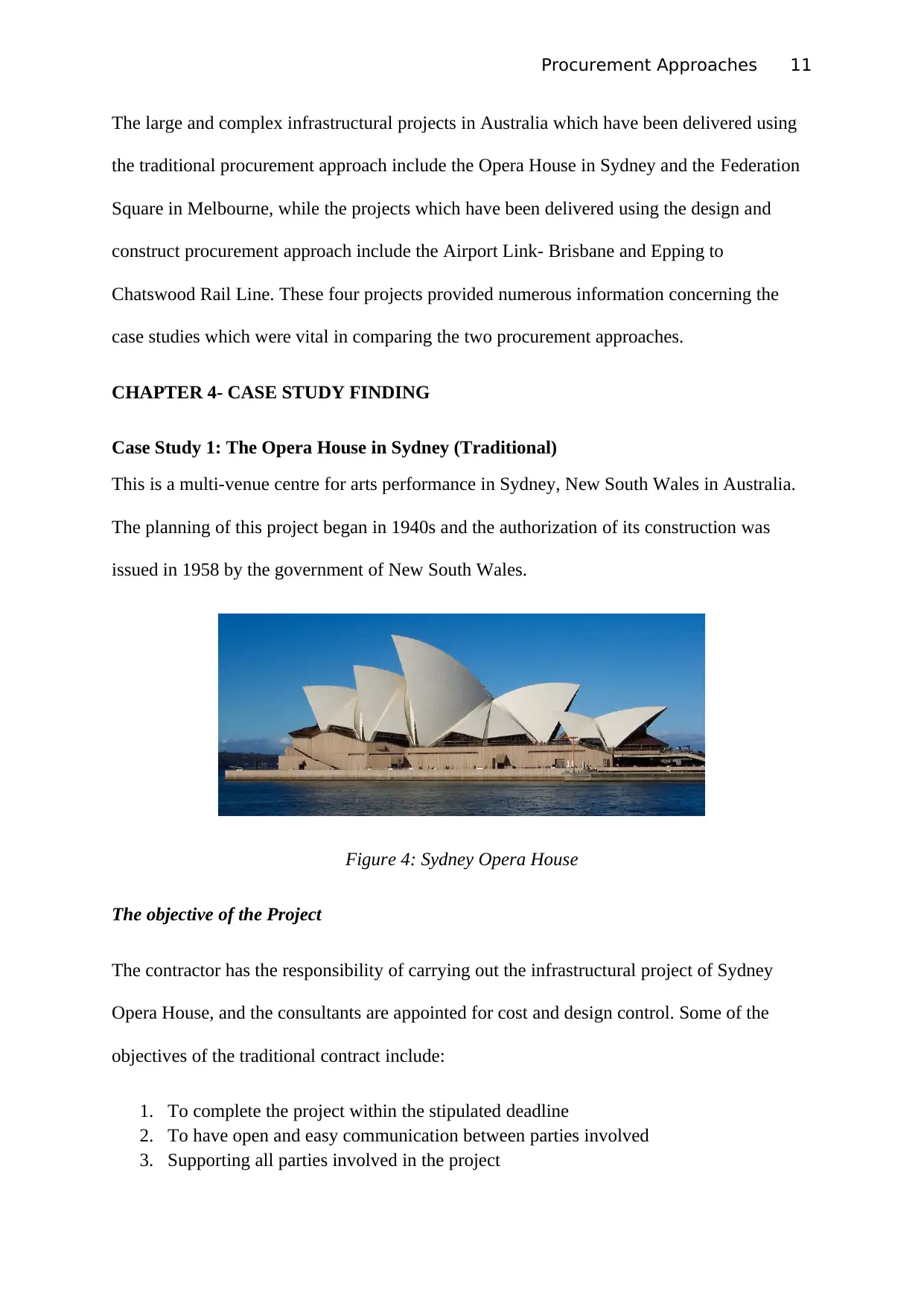
Procurement Approaches 11
The large and complex infrastructural projects in Australia which have been delivered using
the traditional procurement approach include the Opera House in Sydney and the Federation
Square in Melbourne, while the projects which have been delivered using the design and
construct procurement approach include the Airport Link- Brisbane and Epping to
Chatswood Rail Line. These four projects provided numerous information concerning the
case studies which were vital in comparing the two procurement approaches.
CHAPTER 4- CASE STUDY FINDING
Case Study 1: The Opera House in Sydney (Traditional)
This is a multi-venue centre for arts performance in Sydney, New South Wales in Australia.
The planning of this project began in 1940s and the authorization of its construction was
issued in 1958 by the government of New South Wales.
Figure 4: Sydney Opera House
The objective of the Project
The contractor has the responsibility of carrying out the infrastructural project of Sydney
Opera House, and the consultants are appointed for cost and design control. Some of the
objectives of the traditional contract include:
1. To complete the project within the stipulated deadline
2. To have open and easy communication between parties involved
3. Supporting all parties involved in the project
The large and complex infrastructural projects in Australia which have been delivered using
the traditional procurement approach include the Opera House in Sydney and the Federation
Square in Melbourne, while the projects which have been delivered using the design and
construct procurement approach include the Airport Link- Brisbane and Epping to
Chatswood Rail Line. These four projects provided numerous information concerning the
case studies which were vital in comparing the two procurement approaches.
CHAPTER 4- CASE STUDY FINDING
Case Study 1: The Opera House in Sydney (Traditional)
This is a multi-venue centre for arts performance in Sydney, New South Wales in Australia.
The planning of this project began in 1940s and the authorization of its construction was
issued in 1958 by the government of New South Wales.
Figure 4: Sydney Opera House
The objective of the Project
The contractor has the responsibility of carrying out the infrastructural project of Sydney
Opera House, and the consultants are appointed for cost and design control. Some of the
objectives of the traditional contract include:
1. To complete the project within the stipulated deadline
2. To have open and easy communication between parties involved
3. Supporting all parties involved in the project
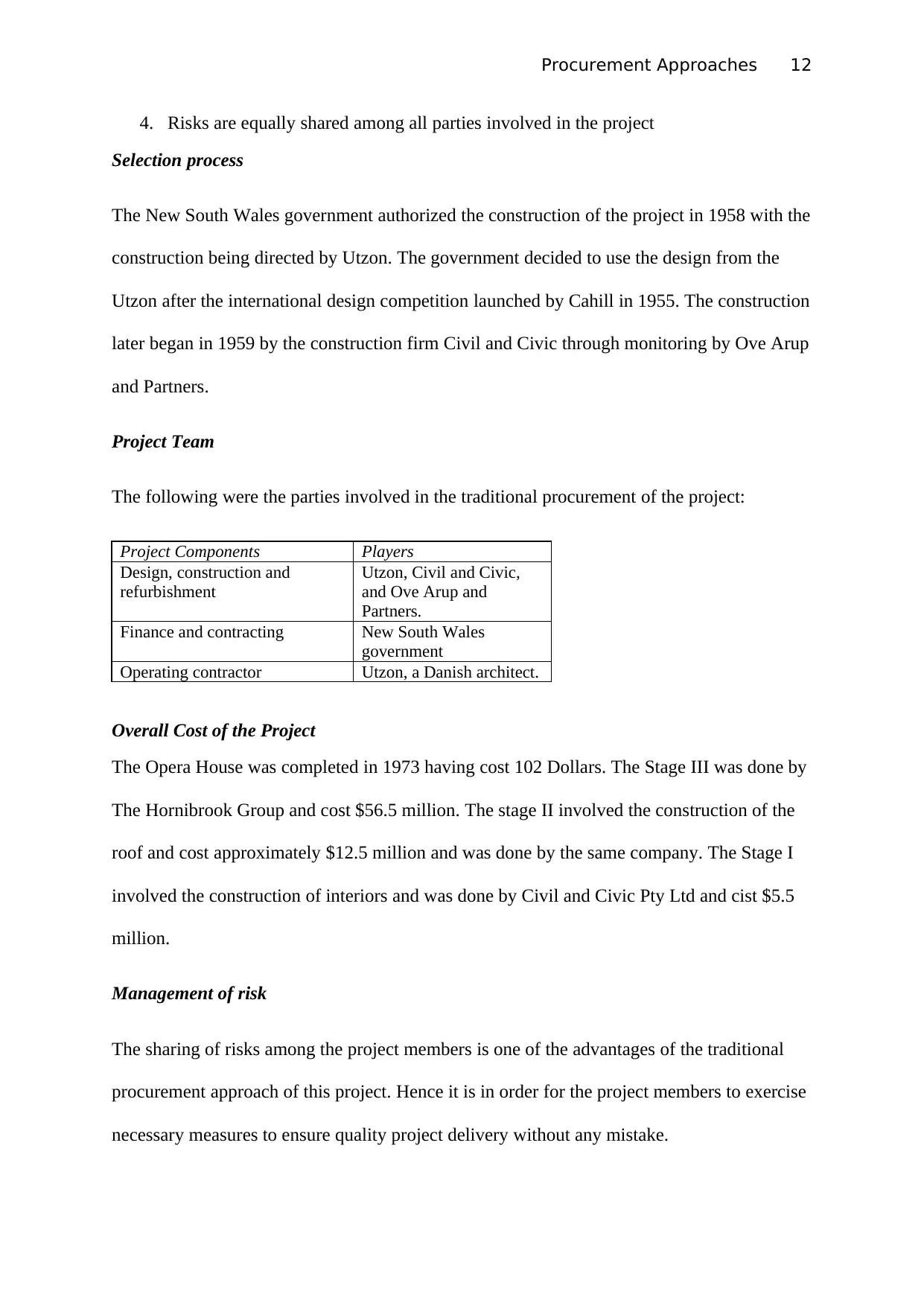
Procurement Approaches 12
4. Risks are equally shared among all parties involved in the project
Selection process
The New South Wales government authorized the construction of the project in 1958 with the
construction being directed by Utzon. The government decided to use the design from the
Utzon after the international design competition launched by Cahill in 1955. The construction
later began in 1959 by the construction firm Civil and Civic through monitoring by Ove Arup
and Partners.
Project Team
The following were the parties involved in the traditional procurement of the project:
Project Components Players
Design, construction and
refurbishment
Utzon, Civil and Civic,
and Ove Arup and
Partners.
Finance and contracting New South Wales
government
Operating contractor Utzon, a Danish architect.
Overall Cost of the Project
The Opera House was completed in 1973 having cost 102 Dollars. The Stage III was done by
The Hornibrook Group and cost $56.5 million. The stage II involved the construction of the
roof and cost approximately $12.5 million and was done by the same company. The Stage I
involved the construction of interiors and was done by Civil and Civic Pty Ltd and cist $5.5
million.
Management of risk
The sharing of risks among the project members is one of the advantages of the traditional
procurement approach of this project. Hence it is in order for the project members to exercise
necessary measures to ensure quality project delivery without any mistake.
4. Risks are equally shared among all parties involved in the project
Selection process
The New South Wales government authorized the construction of the project in 1958 with the
construction being directed by Utzon. The government decided to use the design from the
Utzon after the international design competition launched by Cahill in 1955. The construction
later began in 1959 by the construction firm Civil and Civic through monitoring by Ove Arup
and Partners.
Project Team
The following were the parties involved in the traditional procurement of the project:
Project Components Players
Design, construction and
refurbishment
Utzon, Civil and Civic,
and Ove Arup and
Partners.
Finance and contracting New South Wales
government
Operating contractor Utzon, a Danish architect.
Overall Cost of the Project
The Opera House was completed in 1973 having cost 102 Dollars. The Stage III was done by
The Hornibrook Group and cost $56.5 million. The stage II involved the construction of the
roof and cost approximately $12.5 million and was done by the same company. The Stage I
involved the construction of interiors and was done by Civil and Civic Pty Ltd and cist $5.5
million.
Management of risk
The sharing of risks among the project members is one of the advantages of the traditional
procurement approach of this project. Hence it is in order for the project members to exercise
necessary measures to ensure quality project delivery without any mistake.
⊘ This is a preview!⊘
Do you want full access?
Subscribe today to unlock all pages.

Trusted by 1+ million students worldwide
1 out of 22
Related Documents
Your All-in-One AI-Powered Toolkit for Academic Success.
+13062052269
info@desklib.com
Available 24*7 on WhatsApp / Email
![[object Object]](/_next/static/media/star-bottom.7253800d.svg)
Unlock your academic potential
Copyright © 2020–2025 A2Z Services. All Rights Reserved. Developed and managed by ZUCOL.





